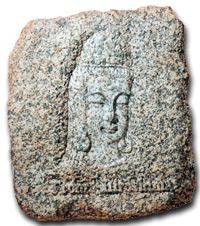


 |
The weight of the Stone is approximately 50 kg. |
43〜45cm |
|
48〜50cm |
 |
| Height | Width | Depth | Weight | |
| Stone | 48〜50cm | 48〜50cm | 30cm | 50kg |
| With the frame | 48〜50cm | 48〜50cm | 50cm | 80〜150kg |
(The size and weight vary) |
||||
 |
Where to display the Stone for Peace is decided by the recipient country in consideration of our request, which is to install in a public area. The Stone is sent in a golden frame that can be displayed indoor as it stands. Some countries place the Stone outside as a peace monument by taking the frame off. |
|
|
|
|
|
The stone monument |
|
|
|
|
A well-known garden architect designed the location of the Stone (Tallinn, Estonia) |
Peace Park of Semey |
Indoor exhibition of National Museum (Sarajevo, Bosnia) |
 |
A professor of Hiroshima University has proved that there is no residual radioactivity harm to human beings left in the Stones. The following is the certificate. |
21 September, 1998 |
|
Certificate of Ratioactivity Inspection |
|
The purpose of this letter is to certify that granite paving stones used for the Hiroshima streetcar at the time of the atomic bomb do not any harmful effect on the human body on the grounds of our measurements. After 53 years since the atomic bomb, it is hard to detect residual radioactivities caused by the bomb. Today, radioactivities detectable by means of the most advanced radiation detectors currently available are as follows: |
|
Professor Dr. Kiyoshi Shizuma |
|
